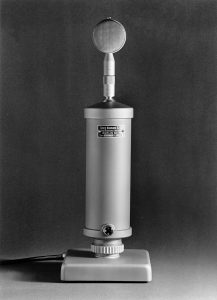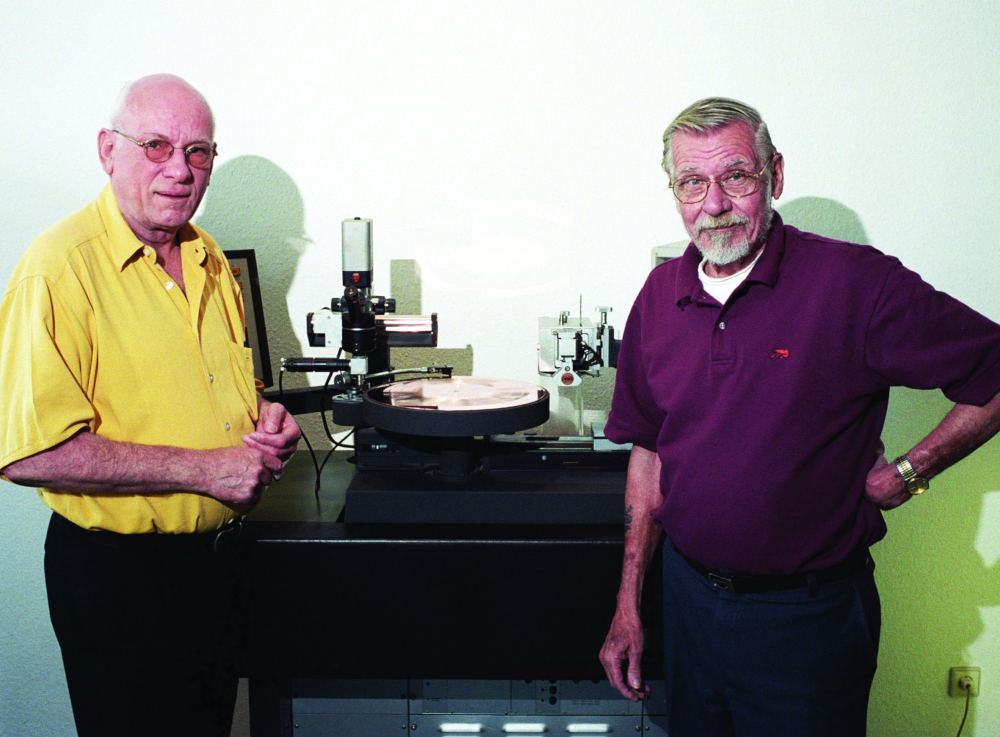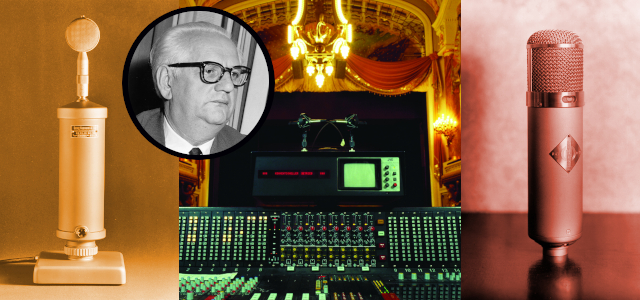
Georg Neumann (1898-1976), among the most influential innovators in early microphone manufacturing, was born on October 13, 1898, in Chorin, Germany, some 80km northeast of Berlin. Although not schooled in the traditional sense of a university degree, Neumann received his vocational training at the firm of Mix & Genest in Berlin. Consequently, it might be surmised that he might fit the mold of a self-taught individual, with appropriate mentors.
Later, Neumann joined the research department of AEG with emphasis on the design and production of audio amplifiers. While at AEG, he became acquainted with Eugen Reisz, who was the director of that particular AEG laboratory and hence was Neumann’s direct supervisor. Reisz had his own ideas about the development of microphones and subsequently left AEG to found his own firm, inviting Neumann to join the new enterprise.
Essence of Microphones
During the period 1920-1930, the microphone was the primary—if not the only essential—instrument for capturing the utterances of talkers and musical performances. To this day, the microphone is still the transducing element of choice when attempting to record, communicate or reinforce such experiences.
Eugen Reisz had his own ideas about the development of microphones and subsequently left AEG to found his own firm, inviting Neumann to join the new enterprise.
Consequently, the microphone is the first encountered element or interface between a talker, orchestral presentation or musical presentation—and eventually the beginning of what ultimately will be a reproduction to the intended listener. Hence, it is no wonder that input transducers (microphones) have received so much attention, acclaim and criticism—sometimes simultaneously.
Considering the wide range of potential applications and individual preferences, it is understandable why no one particular type or design elements of a transducer can be suitable for all the intended usages that, although we haven’t counted them lately, probably number in the several hundreds from an exceedingly wide assortment of manufacturers, and ranging from exceedingly good to horribly dismal.
Microphone Development
It is credited generally that E.C. Wente was the developer of the first (circa 1917) electrostatic (condenser) microphone. However, Wente’s device was somewhat cumbersome, required a large, watt-hungry power supply and, hence, was relegated to a laboratory curiosity or, at best, a device with limited commercial application.
The prevailing microphone technology of the times continued to be the carbon button microphones that had heralded the initial introduction of telephone transmitter technology. Although more or less adequate for telephone speech reproduction, these microphones were sorely lacking when it came to the recording or reproduction of musical content.
In North America, attention turned to the development of dynamic (moving-coil) devices. Meanwhile, in Europe, more attention was being focused on improving the electrostatic concept.
From the time of Thomas Edison and Emil Berliner, the acoustical horn was the preferred method of capturing acoustical (musical) content. An acoustical transducer in its own right, the acoustical horn was not what we would consider a microphone by today’s more stringent standards. (If you doubt this, try listening to some early Caruso recordings.)
In North America, attention turned to the development of dynamic (moving-coil) devices. Meanwhile, in Europe, more attention was being focused on improving the electrostatic concept. The predominant US developer in microphone technology was Western Electric (WE), and dynamic (moving-coil) devices were WE’s primary concern. Wente, by then a member of the WE research team, seemingly was comfortable with this shift in direction.
Enter Neumann
As mentioned, Neumann had joined forces with Reisz to develop a more satisfactory carbon-button-type microphone. According to historical records, Neumann examined the available carbon-button microphones and found them sorely lacking. In an effort to correct these deficiencies, he scattered powdered carbon on a marble slab, inserted two electrodes, introduced a direct current and spoke into this configuration. Neumann noted that the outcome was a very “thin” audio response from the attached loudspeaker. Unsatisfied, he stretched a rubber membrane over the contraption and the low frequencies suddenly were restored.

Despite its limitations, the Reisz microphone found wide acceptance with German radio stations. The device had a linear frequency response of 50Hz to 1Khz with a rising response of 10dB up to 4KHz that then plummeted to 15dB at 10KHz—certainly not suitable for “hi-fi” or recording-studio applications by today’s standards, but a marked improvement over what had been available previously.
Electrostatic Development

Reisz and Neumann differed over several issues. Neumann was of the opinion that the future of microphone technology rested in the development of electrostatic principles. Reisz felt otherwise. And, Neumann’s interest in recording lathes (which we will examine later) aroused Reisz’s ire.
Consequently, in 1928, Neumann created his own company to exploit the further development of (so-called) condenser microphones. With the able assistance and financial acumen of Erich Rickmann, these activities resulted in the development of the CMV 3, dubbed the “Neumann Bottle.”
The CMV 3 was the first-ever mass-produced condenser microphone and proved to be far superior in performance characteristics than the Reisz device. Certainly not a lightweight, the CMV 3 measured 9cm in diameter, approximately 40cm high and weighed in at nearly 3kg (6.6lbs)!
Marketing rights for the Neumann microphone were placed in the hands of Telefunken, a subsidiary of AEG and Siemens. From 1928 until after World War II, the device remained virtually unchanged and became the standard for studio and broadcast entities throughout Germany and many other European countries. There were some modifications to allow the interchange of different polar pattern capsules. A careful review of some of the films from the 1936 Olympics in Berlin reveals the widespread use of CMV 3 microphones by announcers.
The War Years
The Neumann family was beset with difficulties after the Nazis came to power in 1934. Mrs. Neumann was Jewish, and it took the utmost of efforts by Neumann, his employees and his associates to counter the juggernaut of the Nazi regime in their efforts to persecute her, her family and other Jewish company employees. To his credit, Georg Neumann was largely successful in shielding his family and employees from the dreadnaught of the government’s deadly decrees.
In 1943, the Neumann factory in Berlin was destroyed by Allied bombing attacks. Subsequently, Neumann, with several of his key technical personnel and the company’s production staff, relocated to Gefell in what was later to become East Germany, where they set up shop in an abandoned textile mill.
Post-War Years

Although beset with difficulties, Neumann was not idle. During the Gefell days, he developed the M 7 capsule, which subsequently became the engine for the popular U 47 microphone. Introduced in 1947, the U 47 has probably had the greatest influence on the development of modern studio-microphone technology. Its double diaphragm capsule allowed it to be variably switchable between a cardioid and omni pattern. With this degree of control, the U 47 quickly eclipsed the then-prevalent RCA ribbon microphones and the equivalent Altec/WE models. The Neumann U 48 further contributed when it was announced that the new microphone could be polarized, to produce both a cardioid and a figure-eight pattern.
There followed a steady succession of microphone products, including one of the first dual-capsule microphone stereo-recording devices, specialty “shotgun” microphones and a stereophonic “listening head.” These developments added to a diversification that had begun in the 1930s and the early 40s, during which time Neumann had been successful in the addition of electro-acoustic measurement instruments, cinema chimes and broadcast station-identification coded signaling.
As television and stereophonic recording came on the scene in the 1950s, there was more demand for increasingly stringent performance from ever-smaller microphones. And, the small-format diaphragm microphone began competing with the large-format devices that had until then been prevalent. An analogy might be made with the photographic principle of a large-format versus a smaller-format camera (35mm is considered small, 4×5 is large). Typically, you can achieve better images from a large-format camera.
This is not to say that smaller-diaphragm microphones are vastly inferior; however, for recording studios, film scoring and particularly vocal recording, the large-diaphragm microphone remains the unit of choice. Neumann continued to produce large-diaphragm devices, introduced small-format units, and adjusted their marketing accordingly.
Introduced in 1947, the U 47 has probably had the greatest influence on the development of modern studio-microphone technology.
The next significant development was the shift from vacuum-tube technology to transistors and FET circuitry—and the Neumann-introduced concept of 48VDC phantom power. However, as they say, what goes around comes around. As recording studios and serious audiophiles started clamoring for vacuum-tube-equipped processing and power-amplifier products, a similar hue and cry arose for the resurrection of tubed microphones. Neumann responded by introducing the M-149 in 1995. The “49” portion of the model number was no accident, inasmuch as the “new” microphone uses the familiar K47/49 capsule developed by Neumann in 1947.
Disk-Cutting Lathe
As noted earlier, Neumann’s interest in recording apparatus (outside of microphones) became a bone of contention between Neumann and Reisz. This conflict escalated when Neumann was asked to evaluate the prospects for improving a recording lathe being used by some of his friends in England. According to verbal accounts, Neumann found that the apparatus in use was driven by a weight attached to a rope that was lowered from an upper-story window. The falling weight was used to drive a worm gear that, in-turn, was gear-coupled to a belt drive that moved the spindle. Again, according to people who worked with Neumann, he was always intrigued with mechanical solutions to apparent problems. In this case, he was commissioned to devise a more precise means than that involving a weight and a rope. Within several months, he came up with a variable direct drive using an electric motor acting as a direct extension of the turntable spindle.

From this humble beginning, the Neumann recording lathe became an important revenue producer, and was employed widely in disk recording studios up until the demise of vinyl in the 1980s. During this period, a number of improvements in materials and procedures were adapted to provide stereo recording and LP (long-play) recordings.
As Ernst Weiss, a retired engineer for Neumann and Neumann historian, recounts, Neumann’s fascination with mechanical solutions continued into the digital age, despite his passing in 1976. His company, together with Teldec, put considerable time and effort into developing a mechanical lathe for CD mastering. Obviously, laser-cutting technology sent this type of mechanical approach into the ashbin of antiquity.
On Yet Another Front
While exploring means to stabilize the heater voltage of condenser microphones in 1947, Neumann hit on the idea of using a not-yet-available nickel-cadmium battery. In this respect, he developed a process by which such battery devices could be manufactured. Subsequently, the NiCad that is essential for the operation of so many modern electronic devices ranging from photographic flash units to hearing aids, cameras and radios was the result. As history might record it, this may well have been Neumann’s most significant contribution to modern technology.
With the onset of the Cold War, Neumann relocated to Heilbronn in southern Germany to establish a factory for the production of NiCad batteries.
Political Climate
Much of Neumann’s microphone development and related research efforts remained in Gefell. Although Neumann maintained a close relationship with his colleagues in the East German plant, relationships deteriorated as the Communist government imposed increasingly stringent regulations on the exercise of free commerce. In 1961, the Berlin Wall was built, and all interchange of information between Gefell and Berlin was silenced.
By this time, the East German government had nationalized all manufacturing companies and stripped control from previous owners. The Communist government set about producing Neumann microphones in the Gefell plant.
Naturally, such items were not available for export to the Western world, but continued to be distributed in the Eastern Bloc nations. Neumann countered by manufacturing Neumann microphones in Berlin using the name Georg Neumann GmbH. Consequently, for about 25 years, there existed two separate and distinct producers of Neumann microphones.
Georg Neumann passed away in 1976. Thus, he did not live to see the collapse of East Germany and the reunification of the two Germanys; however, his heirs rightfully reclaimed a share of the Eastern Bloc company.
On January 1, 1991, Sennheiser Electronic GmbH & Co. assumed control of Georg Neumann GmbH.
Although Neumann’s developments are regarded widely to be in the fields of condenser microphone and disc-cutting equipment, there was, for a time, a serious—and successful—venture into the mixing console market. Several hundred custom-made consoles were delivered to numerous German and European broadcast facilities, cinema and recording studios, theaters and concert halls.
By the 1970s, Neumann was delivering computer-controlled mixer routing systems and, eventually, full automated mixing consoles. Consoles of this type went to the Berlin Philharmonic, several broadcasting companies and the Media Center of the German Federal Defense Forces.

The Neumann family, which continued to hold a controlling interest in the company after Georg Neumann’s death, decided to sell its shares. After negotiating with several prospective buyers, it was decided to turn the company over as a whole to a similarly structured, family-run German company that had experience in the studio market: On January 1, 1991, Sennheiser Electronic GmbH & Co. assumed control of Georg Neumann GmbH.
To Sennheiser’s credit, the company did not just abruptly assimilate the new holding. Admittedly, the decision was made to discontinue the disc-recording lathe business. By then, the production of vinyl recordings had largely been decimated by the compact disc, and the R&D required to maintain a position in the studio console market made for diminishing returns. Consequently, emphasis was placed on the production and further development of Neumann’s strong position in the condenser microphone market.
Sennheiser continues to produce Neumann microphones in a distinct manufacturing area of the Sennheiser plant in Hannover, Germany. Using a combination of modern machinery and old-fashioned manufacturing processes, Neumann microphones are still crafted in a manner that Georg Neumann would be proud to see bear his name.
Sidebar: NiCad Development
While researching this information, I became curious about the ultimate disposition of Neumann’s efforts in nickel-cadmium battery development. I again turned to Ernst Weiss, who is a living encyclopedia when it comes to Neumann history. According to Weiss:
“After World War II, Neumann lived in Paris, where he had a laboratory, which was the same wherever he lived. He worked at the development of an electrochemical element for the stabilization of small voltages. So he came to the combination of the elements nickel and cadmium. A cell with electrodes of these elements stabilizes small currents with precisely 1.5 volts DC (VDC). Three of these in series stabilized 4.5VDC, which was the heater voltage of the AC 701 tube, later used in most Neumann microphones.
As history might record it, the development of the nickel-cadmium battery may well have been Neumann’s most significant contribution to modern technology.
“These stabilizing cells, called STABILYT, were manufactured in a small Neumann factory in Heilbronn, Germany. The technical manager there was Mr. Teltow. The cells were manufactured as long as they were needed, until the end of the AC 701 series production.
“The gas-tight nickel-cadmium accumulator was a secondary result of Neumann’s research work. He was not interested in manufacturing this product himself, so he sold the patent to Deutsche Edison Accumularoren DEAC, which made a big business with it.”
This article was originally published in the September 2003 issue of Sound & Communications.
Click here for more of Sound & Communications’ “Industry Pioneers” series.
